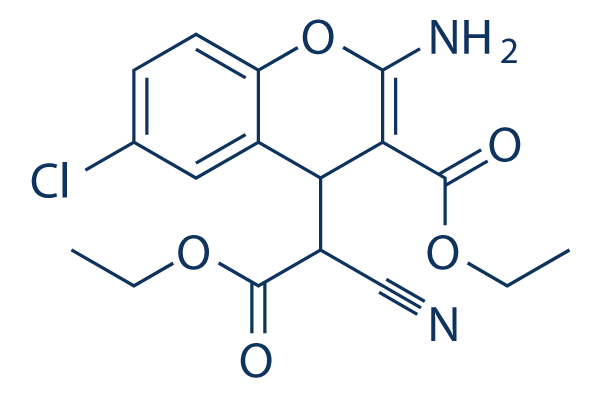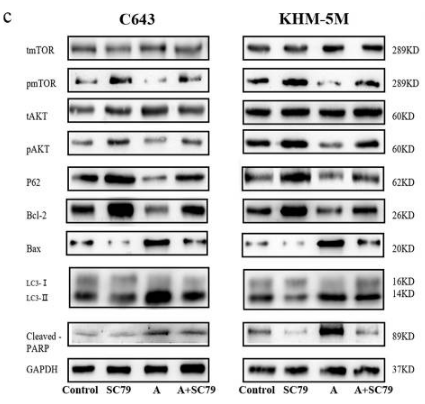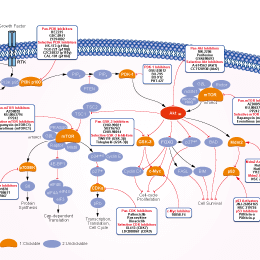
- Bioactive Compounds
- By Signaling Pathways
- PI3K/Akt/mTOR
- Epigenetics
- Methylation
- Immunology & Inflammation
- Protein Tyrosine Kinase
- Angiogenesis
- Apoptosis
- Autophagy
- ER stress & UPR
- JAK/STAT
- MAPK
- Cytoskeletal Signaling
- Cell Cycle
- TGF-beta/Smad
- DNA Damage/DNA Repair
- Compound Libraries
- Popular Compound Libraries
- Customize Library
- Clinical and FDA-approved Related
- Bioactive Compound Libraries
- Inhibitor Related
- Natural Product Related
- Metabolism Related
- Cell Death Related
- By Signaling Pathway
- By Disease
- Anti-infection and Antiviral Related
- Neuronal and Immunology Related
- Fragment and Covalent Related
- FDA-approved Drug Library
- FDA-approved & Passed Phase I Drug Library
- Preclinical/Clinical Compound Library
- Bioactive Compound Library-I
- Bioactive Compound Library-Ⅱ
- Kinase Inhibitor Library
- Express-Pick Library
- Natural Product Library
- Human Endogenous Metabolite Compound Library
- Alkaloid Compound LibraryNew
- Angiogenesis Related compound Library
- Anti-Aging Compound Library
- Anti-alzheimer Disease Compound Library
- Antibiotics compound Library
- Anti-cancer Compound Library
- Anti-cancer Compound Library-Ⅱ
- Anti-cancer Metabolism Compound Library
- Anti-Cardiovascular Disease Compound Library
- Anti-diabetic Compound Library
- Anti-infection Compound Library
- Antioxidant Compound Library
- Anti-parasitic Compound Library
- Antiviral Compound Library
- Apoptosis Compound Library
- Autophagy Compound Library
- Calcium Channel Blocker LibraryNew
- Cambridge Cancer Compound Library
- Carbohydrate Metabolism Compound LibraryNew
- Cell Cycle compound library
- CNS-Penetrant Compound Library
- Covalent Inhibitor Library
- Cytokine Inhibitor LibraryNew
- Cytoskeletal Signaling Pathway Compound Library
- DNA Damage/DNA Repair compound Library
- Drug-like Compound Library
- Endoplasmic Reticulum Stress Compound Library
- Epigenetics Compound Library
- Exosome Secretion Related Compound LibraryNew
- FDA-approved Anticancer Drug LibraryNew
- Ferroptosis Compound Library
- Flavonoid Compound Library
- Fragment Library
- Glutamine Metabolism Compound Library
- Glycolysis Compound Library
- GPCR Compound Library
- Gut Microbial Metabolite Library
- HIF-1 Signaling Pathway Compound Library
- Highly Selective Inhibitor Library
- Histone modification compound library
- HTS Library for Drug Discovery
- Human Hormone Related Compound LibraryNew
- Human Transcription Factor Compound LibraryNew
- Immunology/Inflammation Compound Library
- Inhibitor Library
- Ion Channel Ligand Library
- JAK/STAT compound library
- Lipid Metabolism Compound LibraryNew
- Macrocyclic Compound Library
- MAPK Inhibitor Library
- Medicine Food Homology Compound Library
- Metabolism Compound Library
- Methylation Compound Library
- Mouse Metabolite Compound LibraryNew
- Natural Organic Compound Library
- Neuronal Signaling Compound Library
- NF-κB Signaling Compound Library
- Nucleoside Analogue Library
- Obesity Compound Library
- Oxidative Stress Compound LibraryNew
- Plant Extract Library
- Phenotypic Screening Library
- PI3K/Akt Inhibitor Library
- Protease Inhibitor Library
- Protein-protein Interaction Inhibitor Library
- Pyroptosis Compound Library
- Small Molecule Immuno-Oncology Compound Library
- Mitochondria-Targeted Compound LibraryNew
- Stem Cell Differentiation Compound LibraryNew
- Stem Cell Signaling Compound Library
- Natural Phenol Compound LibraryNew
- Natural Terpenoid Compound LibraryNew
- TGF-beta/Smad compound library
- Traditional Chinese Medicine Library
- Tyrosine Kinase Inhibitor Library
- Ubiquitination Compound Library
-
Cherry Picking
You can personalize your library with chemicals from within Selleck's inventory. Build the right library for your research endeavors by choosing from compounds in all of our available libraries.
Please contact us at [email protected] to customize your library.
You could select:
- Antibodies
- Bioreagents
- qPCR
- 2x SYBR Green qPCR Master Mix
- 2x SYBR Green qPCR Master Mix(Low ROX)
- 2x SYBR Green qPCR Master Mix(High ROX)
- Protein Assay
- Protein A/G Magnetic Beads for IP
- Anti-Flag magnetic beads
- Anti-Flag Affinity Gel
- Anti-Myc magnetic beads
- Anti-HA magnetic beads
- Magnetic Separator
- Poly DYKDDDDK Tag Peptide lyophilized powder
- Protease Inhibitor Cocktail
- Protease Inhibitor Cocktail (EDTA-Free, 100X in DMSO)
- Phosphatase Inhibitor Cocktail (2 Tubes, 100X)
- Cell Biology
- Cell Counting Kit-8 (CCK-8)
- Animal Experiment
- Mouse Direct PCR Kit (For Genotyping)
- New Products
- Contact Us
SC79
SC79 is a brain-penetrable Akt phosphorylation activator and an inhibitor of Akt-PH domain translocation.

SC79 Chemical Structure
CAS No. 305834-79-1
Purity & Quality Control
Batch:
Purity: >97%
97
SC79 Related Products
| Related Targets | Akt1 Akt2 Akt3 | Click to Expand |
|---|---|---|
| Related Products | MK-2206 2HCl Perifosine Capivasertib (AZD5363) GSK690693 Ipatasertib (GDC-0068) Triciribine (API-2) CCT128930 Afuresertib (GSK2110183) A-674563 HCl AT7867 Oridonin Akti-1/2 PHT-427 Miransertib (ARQ 092) HCl AT13148 Uprosertib (GSK2141795) Miransertib (ARQ-092) SC66 Deguelin ML-9 HCl | Click to Expand |
| Related Compound Libraries | Kinase Inhibitor Library PI3K/Akt Inhibitor Library Apoptosis Compound Library Cell Cycle compound library NF-κB Signaling Compound Library | Click to Expand |
Signaling Pathway
Cell Data
| Cell Lines | Assay Type | Concentration | Incubation Time | Formulation | Activity Description | PMID |
|---|---|---|---|---|---|---|
| A549 | Apoptosis assay | 5 μmol/L | SC80 blocks vitexin-induced apoptosis | 30797236 | ||
| HeLa | Function assay | decreased the number of autophagosomes induced by HVJ-E in cells | 30534001 | |||
| SH-SY5Y | Function assay | 10 μM | 30 min | pre-treatment with SC79 (10 μM) largely attenuated H2O2-induced survival reduction | 29560097 | |
| Sertoli | Function assay | 5.5 µM | 30 min | up-regulate the PFOS-induced down-regulation of p-Akt1 T308 and p-Akt1 S473 | 28439067 | |
| Click to View More Cell Line Experimental Data | ||||||
Biological Activity
| Description | SC79 is a brain-penetrable Akt phosphorylation activator and an inhibitor of Akt-PH domain translocation. | |
|---|---|---|
| Targets |
|
| In vitro | ||||
| In vitro | SC79 suppresses PHAKTM-GFP plasma membrane translocation, and enhances phosphorylation of all three Akt isoforms in HEK293, HeLa, HL60, NB4, and HsSulton (B cells) cells. SC79 reduces neuronal excitotoxicity and prevents stroke-induced neuronal death. [1] SC79 restores proliferation of BRAT1 knockdown cells, and reduces the production of superoxide in mitochondria of MitoSox positive cells. [2] |
|||
|---|---|---|---|---|
| Kinase Assay | Cytosolic phosphorylation of Akt | |||
| Hela cells are serum starved for 1 hr and treated with IGF (100ng/mL) or SC79 (4 μg/mL) for 30 minutes. Cells are lysed in Lysis buffer containing 250 mM Sucrose, 20 mM HEPES, 10 mM KCl, 1.5 mM MgCl2, 1 mM EDTA, 1 mM EGTA supplemented with protease inhibitors. Cells are passed through 25G needle several times and kept on ice for 20 minutes. Total cell lysate is taken at this point. Cell lysates are centrifuged at 100,000g for 30 minutes. Supernatant is collected as the cytosolic fraction. Pellet is washed with lysis buffer and represents the membrane fraction. Total cell lysate, cytosolic and membrane fractions are resolved by SDS-PAGE and analyzed for phospho-Akt (S473), Total Akt, Tubulin (cytosolic marker) and Orai1 (membrane marker) by western blotting. | ||||
| Cell Research | Cell lines | HsSultan and NB4 cells | ||
| Concentrations | 8 μg/mL | |||
| Incubation Time | 24 h | |||
| Method | HsSultan or NB4 cells (2.5 × 105) are plated in a 24-well plate in 500 μL of phenol red-free RPMI medium supplemented with 10% FBS. After incubation for 24 hours, each compound (8 µg/mL) is added and cultured for overnight (16–20 h). Fifty microliters of MTT solution (5 mg/mL in PBS) are added to each well. Following 2 hrs incubation, the purple formazan crystals are dissolved by directly adding in 500 μL of isopropanol with 0.1 M HCl to each well. After clearing the cell debris by centrifugation, the absorbance is measured at a wavelength of 570 nm. |
|||
| Experimental Result Images | Methods | Biomarkers | Images | PMID |
| Western blot | p-mTOR / mTOR / pAKT / AKT / P62 / Bcl-2 / Bax / LC3 / Cleaved PARP p-Akt / Akt / p-GSK3β / GSK3β / β-catenin / Cyclin D1 p4EBP1 / 4EBP1 / pS6 / RPS6 / ESRP1 / ESRP2 |

|
30301881 | |
| In Vivo | ||
| In vivo | In the permanent focal cerebral ischemia mouse model, SC79 (0.04 mg/g, i.p.) enables the cytosolic activation of Akt, and recapitulates the primary cellular function of Akt signaling, resulting in augmented neuronal survival. [1] |
|
|---|---|---|
| Animal Research | Animal Models | Permanent focal cerebral ischemia mouse model |
| Dosages | 0.04 mg/g | |
| Administration | i.p. | |
Chemical Information & Solubility
| Molecular Weight | 364.78 | Formula | C17H17ClN2O5 |
| CAS No. | 305834-79-1 | SDF | Download SC79 SDF |
| Smiles | CCOC(=O)C1=C(OC2=C(C1C(C#N)C(=O)OCC)C=C(C=C2)Cl)N | ||
| Storage (From the date of receipt) | |||
|
In vitro |
DMSO : 73 mg/mL ( (200.12 mM) Moisture-absorbing DMSO reduces solubility. Please use fresh DMSO.) Ethanol : 36 mg/mL Water : Insoluble |
Molecular Weight Calculator |
|
In vivo Add solvents to the product individually and in order. |
In vivo Formulation Calculator |
||||
Preparing Stock Solutions
Molarity Calculator
In vivo Formulation Calculator (Clear solution)
Step 1: Enter information below (Recommended: An additional animal making an allowance for loss during the experiment)
mg/kg
g
μL
Step 2: Enter the in vivo formulation (This is only the calculator, not formulation. Please contact us first if there is no in vivo formulation at the solubility Section.)
% DMSO
%
% Tween 80
% ddH2O
%DMSO
%
Calculation results:
Working concentration: mg/ml;
Method for preparing DMSO master liquid: mg drug pre-dissolved in μL DMSO ( Master liquid concentration mg/mL, Please contact us first if the concentration exceeds the DMSO solubility of the batch of drug. )
Method for preparing in vivo formulation: Take μL DMSO master liquid, next addμL PEG300, mix and clarify, next addμL Tween 80, mix and clarify, next add μL ddH2O, mix and clarify.
Method for preparing in vivo formulation: Take μL DMSO master liquid, next add μL Corn oil, mix and clarify.
Note: 1. Please make sure the liquid is clear before adding the next solvent.
2. Be sure to add the solvent(s) in order. You must ensure that the solution obtained, in the previous addition, is a clear solution before proceeding to add the next solvent. Physical methods such
as vortex, ultrasound or hot water bath can be used to aid dissolving.
Tech Support
Answers to questions you may have can be found in the inhibitor handling instructions. Topics include how to prepare stock solutions, how to store inhibitors, and issues that need special attention for cell-based assays and animal experiments.
Tel: +1-832-582-8158 Ext:3
If you have any other enquiries, please leave a message.
* Indicates a Required Field
Tags: buy SC79|SC79 ic50|SC79 price|SC79 cost|SC79 solubility dmso|SC79 purchase|SC79 manufacturer|SC79 research buy|SC79 order|SC79 mouse|SC79 chemical structure|SC79 mw|SC79 molecular weight|SC79 datasheet|SC79 supplier|SC79 in vitro|SC79 cell line|SC79 concentration|SC79 nmr|SC79 in vivo|SC79 clinical trial|SC79 inhibitor|SC79 PI3K/Akt/mTOR inhibitor







































